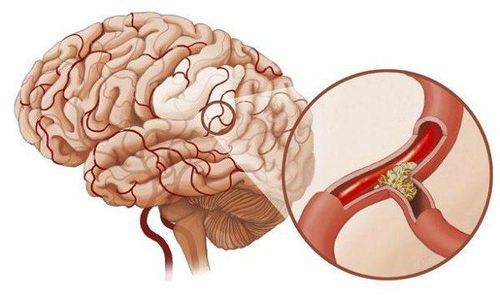This is an automatically translated article.
The pituitary gland is an endocrine gland that secretes many important hormones that control the activities of many other endocrine glands in the body. As one of the four most common intracranial tumors (including brain metastases, meningiomas, gliomas, and pituitary tumors), pituitary adenomas are usually slow-growing.So are pituitary tumors dangerous? What treatments are there for pituitary tumors?
1. What is the pituitary gland?
The pituitary gland is a hormone gland located in the brain. The pituitary gland secretes a variety of hormones that help regulate the secretion of hormones from other endocrine glands in the body such as the thyroid gland, the adrenal gland,... In addition, the pituitary gland also secretes hormones that have a beneficial effect. Acts directly on body tissues such as bones and milk-producing glands. The hormones of the pituitary gland include:
Adrenocorticotropic hormone (ACTH) that stimulates the adrenal cortex Growth hormone (GH) is a growth hormone Prolactin hormone: increases lactation Thyroid-stimulating hormone (TSH) stimulates the thyroid gland
2. Are pituitary tumors dangerous?
A pituitary tumor is a tumor that develops from cells of the pituitary gland. So are pituitary tumors dangerous? According to many studies, about 1 in 10 adults will have a pituitary tumor. So this is a fairly common disease, but fortunately most of these tumors are very small, have no clinical symptoms or never show any symptoms and do not require treatment.
Most pituitary tumors are benign. The percentage of people with malignant pituitary tumors and needing treatment is very low. Of the total number of patients undergoing surgery for intracranial tumors, only 25% are due to pituitary tumors.
The pituitary gland has many different types of cells, each of which secretes a corresponding hormone and affects different organs of the body. Therefore, there are many types of pituitary tumors, but they can be divided into two main groups:
Hypersecretory pituitary tumors: are tumors that arise from hormone-secreting cells. The gland cells develop into tumors and secrete too many hormones that affect other organs, disrupting their activities. Non-secretory pituitary tumors: are tumors that arise from non-hormonal glandular cells, so the hormone in these patients is not increased or even decreased. The pituitary tumor grows larger and larger, pressing on the surrounding healthy pituitary cells, thereby reducing or disrupting hormone secretion. When the tumor is larger, it puts pressure on the surrounding brain structures, causing compression syndrome like other tumors in the skull.
In addition to the above classification, there are other ways to classify adenomas such as:
Classification based on the size of the tumor is divided into 2 groups: Microadenoma is a pituitary tumor smaller than 1 cm . A large pituitary tumor (Macroadenoma) is a tumor of the pituitary gland that is 1 cm or larger. Classification based on the growth rate of the tumor is divided into 2 groups: Slow-growing pituitary tumors. Fast-growing pituitary tumor.

U tuyến yên là bệnh rất phổ biến, đây đa phần là khối u lành tính, hiếm khi là ác tính
3. What is the cause of pituitary tumor?
As with most other intracranial tumors, the cause of pituitary adenomas is still unknown. A few cases are due to genetics such as giantism in the family, some cases of pituitary tumors are found in the setting of multiple endocrine neoplasms of group 1.
4. Pituitary tumor symptoms
Symptoms of a pituitary tumor depend on:
The type of hormone the tumor secretes Tumor size Tumor location Tumor location The degree of tumor growth Pituitary tumor growth will usually cause 3 groups of symptoms The following:
4.1 Symptoms of hormonal disorders
Increased secretion of Prolactin: patients will experience delayed menstruation, menstrual disorders, even amenorrhea, infertility, lactation even though they are not pregnant or not menstruating. Many patients, when undergoing treatment for infertility, found that prolactin levels were elevated when tested, and then tested to find a pituitary tumor. In male patients, there may be a decrease in sex drive, a decrease or loss of the ability to get an erection.
Hypersecretion of GH hormone: this condition causes the patient to develop many other disorders such as large face, wide forehead, protruding forehead, wide chin, thick lips, rough skin, enlarged extremities, large feet and toes causing the patient can't find shoes that fit his feet, his hands and fingers are so big that he can't wear a ring,... The patient's face with GH-secreting pituitary adenoma is very special, the doctor can diagnose directly based on the observation of the face.
Increased secretion of ACTH hormone causes Cushing's disease: patients often have weight gain, stretch marks on the abdomen, arms, thighs, ... big belly, flat muscles, small limbs.
Signs of hypopituitarism: with non-secreting pituitary gland tumor, it presses on the healthy pituitary cells, causing the pituitary gland to decline, reducing the secretion of hormones, causing signs such as hair loss, impotence, infertility, fatigue, loss of appetite, dry skin, growth spurts or delayed puberty in children,... Some cases of bleeding in the pituitary gland can cause signs of acute hypopituitarism, the Symptoms appear quickly such as: severe headache, severe pain, blurred vision quickly. This is a neurosurgery emergency that requires prompt management.
4.2 Symptoms of visual disturbances
The pituitary gland is located in the pituitary fossa just below the optic nerve - where the two optic nerves cross - so when the pituitary tumor is large, it presses on, causing disturbances in the patient's vision. The patient may have: blurred vision, hemiplegia - only one side can see inside or outside.
Temporal hemiparesis: the patient can only see the image in front of him, not the objects outside the temple. Nasal hemiparesis: the patient can only see the outer objects but cannot see the inner objects. Strabismus, double vision, facial numbness, ... due to tumor invasion to the side, into the cavernous sinus, pressing on cranial nerves III, IV, V.
4.3 Symptoms of compression tumor causing increased intracranial pressure
When the tumor compresses in the skull causing increased intracranial pressure, the patient will have symptoms such as:
Headache Nausea Consciousness disorder, possibly even coma.
5. Subclinical tests to help diagnose pituitary tumors
Along with a careful clinical examination, the doctor may order the patient to do a number of laboratory tests to diagnose pituitary adenoma, including:
Endocrine function test Cortisol quantification: by test suppression or urine cortisol test. The amount of the hormone FSH The amount of the hormone IGF-1 The amount of the hormone LH The amount of the hormone Prolactin in the blood The amount of the hormone Testosterone/estradiol in the blood. Thyroid hormone levels: TSH, free T4,... Other tests CT scan or brain MRI helps to determine the exact location and size of the pituitary tumor. Field measurement, vision test: helps determine if the tumor has affected vision or vision.
6. How to treat pituitary gland tumor?
Pituitary tumors are usually benign and have not spread to other parts of the body. However, when the tumor grows, it can put pressure on important nerves and blood vessels, so when detecting a pituitary tumor, depending on the condition, the doctor will give appropriate treatment. Here are some treatments for pituitary tumors.6.1.Surgery
Surgery for pituitary tumors is often necessary, especially when the tumor compresses the optic nerve, has a risk of blindness for the patient, or the tumor causes increased secretion of certain hormones. The success rate of surgery depends on many factors such as:
Type of tumor Tumor location Tumor size The tumor has invaded into nearby tissues or not. There are two techniques for removing pituitary tumors:
Transnasal endoscopic surgery: this technique allows the surgeon to remove the tumor without making a cut outside the skull. Does not affect other parts of the brain. However, for large tumors, it can be difficult to remove with this technique, especially those that have invaded the surrounding brain tissue and nerves. Transcranial surgery: The pituitary tumor is removed through cuts in the scalp and skull. This technique will make it easier for doctors to access large and complex tumors.

Một trong những biện pháp để điều trị u tuyến yên là phẫu thuật
6.2. Radiotherapy
Radiation therapy is often used after surgery or patients are not suitable for surgery. This method is useful if the tumor persists for a long time or if the tumor recurs after surgery, or does not respond to drug treatment.
The following radiotherapy methods are available for pituitary tumors:
Targeted radiosurgery using Gamma Knife: this type of radiation focuses beams of radiation on the tumor, usually using a single high dose. This technique allows the delivery of radiation beams equivalent to the size and shape of the tumor to the tumor without making a cut, with the help of brain imaging techniques. This method reduces the risk of damage to the normal tissue surrounding the tumor. Using external radiation: This technique delivers small amounts of radiation to the tumor over time. A course of treatment takes about 5 days/week, conducted for 4-6 weeks. While this technique is often effective, it has several disadvantages: It can damage normal pituitary cells and other brain cells. Treatment is lengthy, and it can take years to fully control tumor growth and control hormone secretion. Using proton beam: this technique uses positively charged ions instead of using X-rays. The difference is that the proton beam will stop as soon as it releases energy inside the target. The advantage of this technique is that the beam can be controlled and used on tumors, with little effect on healthy tissue. However, this technique requires special modern equipment, which is less common.
6.3. Use medicine
Bromocriptine or Cabergoline is the first choice for prolactin-secreting tumors. These drugs help reduce prolactin levels and shrink tumors. Octreotide or Pegvisomant is sometimes used to treat growth hormone-secreting tumors, especially when surgery is less likely to cure. However, there are many patients with pituitary tumors who can function normally without treatment, as long as the tumor does not cause problems for the patient's health. In this case, the patient should be closely monitored with tests on a regular basis to assess tumor growth, and treatment will be needed as needed.
The choice of treatment method for pituitary tumor depends on many factors such as tumor type, size, tumor location, patient's health, and medical facility's equipment. Therefore, to know which treatment method you are suitable for, you need to be carefully examined and then talk to a specialist.
To register for examination and treatment at Vinmec International General Hospital, you can contact the nationwide Vinmec Health System Hotline, or register online HERE.
In April & May 2021, when there is a need for examination and treatment of pituitary tumor at Vinmec Central Park International General Hospital, customers will enjoy double incentives:
- Free specialist examination
- 50% discount for customers with post-examination treatment indications. The program is limited to the corresponding technique of each hospital and to customers who perform this treatment technique for the first time at Vinmec.
Please dial HOTLINE for more information or register for an appointment HERE. Download MyVinmec app to make appointments faster and to manage your bookings easily.













